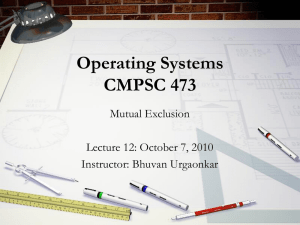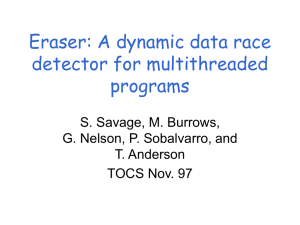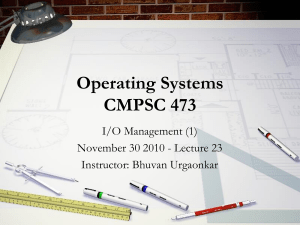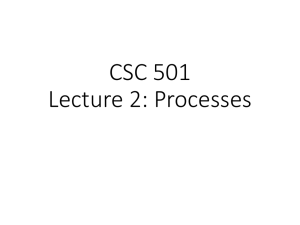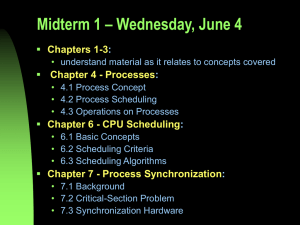4. The OS Kernel
advertisement
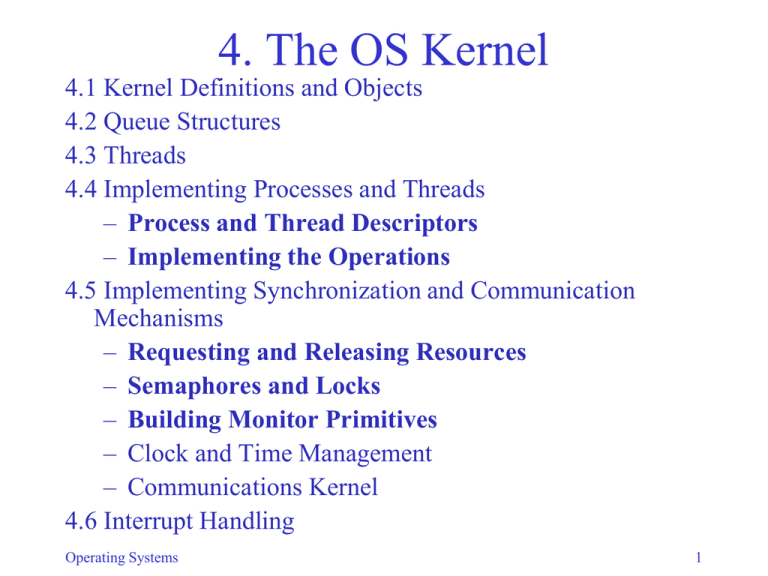
4. The OS Kernel
4.1 Kernel Definitions and Objects
4.2 Queue Structures
4.3 Threads
4.4 Implementing Processes and Threads
– Process and Thread Descriptors
– Implementing the Operations
4.5 Implementing Synchronization and Communication
Mechanisms
– Requesting and Releasing Resources
– Semaphores and Locks
– Building Monitor Primitives
– Clock and Time Management
– Communications Kernel
4.6 Interrupt Handling
Operating Systems
1
The OS Kernel
• OS Kernel: basic set of objects, processes, primitives
• Rest of OS is built on top of kernel
• Kernel provides
mechanisms
to implement
different
policies
CompSci 143A
2
Processes and threads
• Process has one or more
threads
• Each thread has its own:
– CPU state (registers, PC)
– Stack
• All threads in a process share:
– Memory space
– Other resources
• Threads are efficient, but lack
protection from each other
• Processes/threads run
concurrently
Operating Systems
3
The Ready List (RL)
• Each process is represented by a PCB
• PCBs reside on different lists: waiting list, ready list
• Example: priority queue:
Operating Systems
4
Process Status
• Process is a “living” entity:
– Alternates between states: Running / Ready / Blocked
• Running: process is currently running on a CPU
• Ready: process is ready to run, waiting for a CPU
• Blocked: process is waiting for some resource (lock, file,
semaphore, message, …)
• Each state can be Active or Suspended (sub-state)
• Suspended: process cannot run (similar to blocked) but:
– Not waiting for any resource
– Suspended explicitly by another process (e.g. to
examine or modify its state, prevent deadlock, detect
runaway process, swap process out of memory, …)
Operating Systems
5
The State Transition Diagram
Operating Systems
6
The Process Control Block (PCB)
•
•
•
•
•
•
•
•
•
•
ID
CPU_State: registers, flags
Proc_ID: for multiprocessors
Memory: addresses, page
table
Open_Files
Other_Resources
Stat type: running, ready,
blocked (suspended)
Stat list: pointer to
RL or wait list
Parent/Child:
creation hierarchy
Priority
Operating Systems
7
Process Operations: Create
Create(s0, m0, pi) {
p = Get_New_PCB(); pid = Get_New_PID();
p->ID = pid;
p->CPU_State = s0;
p->Memory = m0; p->Priority = pi;
p->Status.Type = ’ready_s’;
p->Status.List = RL;
p->Creation_Tree.Parent = self;
p->Creation_Tree.Child = NULL;
insert(self->Creation_Tree.Child, p);
insert(RL, p);
Scheduler();
}
Operating Systems
8
Process Operations: Suspend
Suspend(pid) {
p = Get_PCB(pid);
s = p->Status.Type;
if ((s==’blocked_a’)||(s==’blocked_s’))
p->Status.Type = ’blocked_s’;
else p->Status.Type = ’ready_s’;
if (s==’running’) {
cpu = p->Processor_ID;
p->CPU_State = Interrupt(cpu);
Scheduler();
}
}
Operating Systems
9
Process Operations: Activate
Activate(pid) {
p = Get_PCB(pid);
if (p->Status.Type == ’ready_s’) {
p->Status.Type = ’ready_a’;
Scheduler();
}
else p->Status.Type = ’blocked_a’;
}
Operating Systems
10
Process Operations: Destroy
Destroy(pid) {
p = Get_PCB(pid); Kill_Tree(p); Scheduler();}
Kill_Tree(p) {
for (each q in p->Creation_Tree.Child)
Kill_Tree(q);
if (p->Status.Type == ’running’) {
cpu = p->Processor_ID; Interrupt(cpu);
}
Remove(p->Status.List, p);
Release_all(p->Memory);
Release_all(p->Other_Resources);
Close_all(p->Open_Files);
Delete_PCB(p);
}
Operating Systems
11
Resource Management
• Resources: semaphores,
monitors, messages, time,
files, devices, etc.
• Generic code to
request/release resource
• Instantiated for each
type of resource
• Example:
– if resource is a
semaphore
– then request/release is
P/V
Operating Systems
Request(res) {
if (Free(res))
Allocate(res, self)
else {
Block(self, res);
Scheduler(); }
}
Release(res) {
Deallocate(res, self);
if (Proc_Blocked_on(res,pr))
{ Allocate(res, pr);
Unblock(pr, res);
Scheduler(); }
}
12
Implementing semaphores
• Each semaphore operation, P/V, must be atomic (CS)
• Use special hardware instruction: test_and_set
• First implementing binary semaphores using test_and_set
• Then implement general semaphores using binary
semaphores and busy waiting
• Finally, avoid busy wait using process blocking
Operating Systems
13
Test_and_Set Instruction
• Special hardware instruction: TS(R,X)
• R is a register (private), X is a variable (shared)
• Semantics: R = X; X = 0;
• Explanation:
– Always set variable X = 0
– Register R indicates whether X changed:
• R=1 if X changed (10)
• R=0 if X did not change (00)
• TS is a machine instruction, i.e. indivisible (atomic)
• If multiple processes execute TS and X=1, only one will
reset it, the other sees no change
Operating Systems
14
Binary Semaphores
• test_and_set can implement binary semaphores, sb:
• Has only two values, 0 or 1
• Two atomic operations:
Pb(sb): if (sb==1) sb=0;
else wait until sb becomes 1
Vb(sb): sb=1;
• Implementation using TS instruction:
Pb(sb): do (TS(R,sb)) while (!R);
/*wait loop*/
Vb(sb): sb=1;
• Also known as a spin lock (“Spinning” = “Busy Waiting”)
Operating Systems
15
Binary Semaphores
• test_and_set is crucial for the implementation
• Compare :
Pb(sb):
do (TS(R,sb)) while (!R); /*wait loop*/
Pb(sb):
while (sb==0) ; /*do nothing -- wait loop*/
sb = 0;
• Both are testing sb for 0
• Why is second implementation NOT sufficient?
Operating Systems
16
General Semaphores w/ busy wait
P(s) {
Inhibit_Interrupts;
Pb(mutex_s);
s = s-1;
if (s < 0) {
Vb(mutex_s);
Enable_Interrupts;
Pb(delay_s); }
Vb(mutex_s);
Enable_Interrupts; }
V(s) {
Inhibit_Interrupts;
Pb(mutex_s);
s = s+1;
if (s <= 0) Vb(delay_s);
else Vb(mutex_s);
Enable_Interrupts; }
Operating Systems
• Pb(delay_s) implements the
actual waiting (busy wait!)
• mutex_s protects access to s
(critical section)
• Inhibit_interrupt prevents
deadlock
– Assume a process is in P or V
– Context switch wakes up
higher-priority process that tries
to execute P or V
• mutex_s is still needed on
multiprocessor
• Note: s can become negative
– Serves as a counter of
waiting processes
17
General Semaphores w/out busy wait
P(s) {
Inhibit_Interrupts;
Pb(mutex_s);
s = s-1;
if (s < 0) {
Block(self, Ls);
Vb(mutex_s);
Enable_Interrupts;
Scheduler(); }
else {
Vb(mutex_s);
Enable_Interrupts; } }
• Ls is a blocked list for
semaphore s
Operating Systems
V(s) {
Inhibit_Interrupts;
Pb(mutex_s);
s = s+1;
if (s <= 0) {
Unblock(q,Ls);
Vb(mutes_s);
Enable_Interrupts;
Scheduler(); }
else {
Vb(mutex_s);
Enable_Interrupts; } }
• Block/Unblock only
change data structures
• Scheduler performs
context switch
18
Implementing Monitors
• Compiler need to insert code to:
– Guarantee mutual exclusion of procedures
(entering/leaving)
– Implement c.wait
– Implement c.signal
• Use 3 types of semaphores:
– mutex: for mutual exclusion
– condsem_c: for blocking on each condition c
– urgent: for blocking process after signal, to implement
special high-priority queue
Operating Systems
19
Implementing Monitor Primitives
• Code for each procedure:
P(mutex);
[procedure_body;]
if (urgentcnt > 0) V(urgent);
else V(mutex);
• Code for c.wait:
Code for c.signal:
if (condcnt_c) {
urgentcnt = urgentcnt +1;
V(condsem_c);
P(urgent);
urgentcnt = urgentcnt –1;
}
condcnt_c = condcnt_c + 1;
if (urgentcnt > 0) V(urgent);
else V(mutex);
P(condsem_c);
condcnt_c = condcnt_c - 1;
Operating Systems
20


